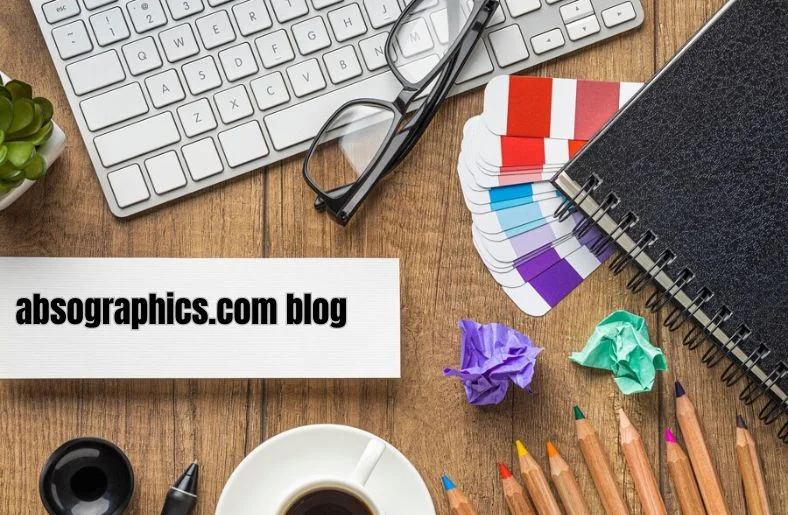
Introduction
Graphic design is all about creating visuals that capture attention, convey messages, and leave a lasting impression. Whether you’re a seasoned designer or a curious newbie, there’s always something new to learn that can take your designs from “meh” to magnificent. That’s exactly where absographics.com blog comes in, offering the knowledge and tools you need to sharpen your skills and stay ahead of the curve.
In this blog, we’ll uncover seven must-know graphic design techniques that every designer should have up their sleeve. These techniques range from mastering color harmony to embracing negative space, each one adding a touch of magic to your creative projects. If you’re ready to up your design game and make your visuals pop, read on!
1. Harness the Power of Color Harmony
Color isn’t just for decoration; it’s a crucial element that can make or break your design. Understanding color harmony will allow you to create visuals that evoke emotions and guide the viewer’s eye to key elements.
Why Color Matters
Think about the last time a vivid sunset took your breath away. That’s the power of color. Colors have the ability to set the mood, express emotions, and even drive action. In graphic design, using the right color combinations can strengthen your message, while clashing colors can confuse or repel your audience.
Color Wheel Basics
The color wheel is your best friend when it comes to finding the perfect palette. Here’s how you can use it:
- Complementary Colors: Colors opposite each other on the wheel (like red and green) create contrast, which can make your design more vibrant.
- Analogous Colors: Colors next to each other on the wheel (like blue and green) create a harmonious look, perfect for more subtle and sophisticated designs.
- Triadic Colors: Using three colors evenly spaced on the wheel (like red, yellow, and blue) can add a playful and balanced touch to your design.
Take time to play with the color wheel. It’s not just a circle of hues; it’s a map that can lead you to the perfect color choices for any project.
2. Master the Use of Typography
Typography is more than just selecting a cool font; it’s about giving your text a voice. Just as you wouldn’t use the same tone of voice for every conversation, you shouldn’t use the same font for every message.
Choosing the Right Font
Different fonts convey different moods:
- Serif Fonts: These fonts, like Times New Roman, add a classic and formal feel to your design.
- Sans-Serif Fonts: Fonts like Arial or Helvetica are modern and clean, great for more casual or contemporary designs.
- Script Fonts: Perfect for adding elegance or a handwritten touch, but use them sparingly—they can easily overwhelm a design.
Create a Hierarchy
Imagine trying to read a book where all the text looks the same. Boring, right? In design, you need to guide the reader’s eye, and that’s where font hierarchy comes in. Use different font sizes and weights to emphasize important information and help the viewer know where to look first.
3. Embrace Negative Space Like a Pro
Negative space (or white space) is the area around and between the main elements of your design. Think of it as the quiet part of a song—absographics.com blog gives your eyes a moment to rest and makes the main elements stand out.
Why Negative Space is a Big Deal
Cluttered designs feel overwhelming. By leaving some areas untouched, you create balance and focus. It’s like allowing your design to breathe. Ever seen the FedEx logo? It has a hidden arrow formed by negative space between the “E” and “x.” That’s how you turn nothing into something!
Tips for Using Negative Space
- Avoid overstuffing your design: Less is often more.
- Use it to create shapes: Cleverly placed negative space can form hidden images or suggest movement.
- Improve readability: Negative space can make text easier to read by reducing visual clutter.
4. Learn the Art of Alignment
Alignment isn’t just about making things look neat and tidy; it’s about creating a connection between elements and organizing content so it feels intentional.
Types of Alignment
There are several ways to align elements, each bringing its own effect:
- Left Alignment: The most common type, used for body text to create a clean and professional look.
- Center Alignment: Great for headlines or minimalistic designs, but use it sparingly—too much centered text can feel off-balance.
- Right Alignment: Less common but effective for unique designs or creating a modern look.
- Grid Alignment: Use grids to position elements consistently. It gives structure to your layout and makes the design look cohesive.
Benefits of Good Alignment
Think of alignment as the foundation of your design. When everything lines up, it gives your visuals a polished appearance. It’s like when you tidy up your room—suddenly, everything feels in place.
5. Use Contrast to Make Elements Pop
Contrast is one of the most powerful tools in a designer’s toolkit. It refers to the difference between two elements, whether it’s color, size, shape, or texture. When used effectively, contrast can draw attention to key areas and make your design more dynamic.
Ways to Create Contrast
- Color Contrast: Use light and dark colors to make elements stand out.
- Size Contrast: Mix large and small elements to create visual interest.
- Font Contrast: Combine bold and light fonts to differentiate headings from body text.
Remember, contrast isn’t just for show. It serves a purpose, guiding the viewer’s eye to the most important parts of your design.
6. Incorporate Texture for a Tactile Feel
Digital designs don’t have to feel flat. By adding texture, you can give your design a sense of depth and tactile quality. It’s like transforming a 2D space into something that feels almost touchable.
Adding Texture to Your Designs
- Use textured backgrounds like paper or fabric for a natural look.
- Overlay textures on images to create a vintage or grungy effect.
- Apply texture to text for a handmade feel.
However, remember that too much texture can overwhelm the design. Use absographics.com blog like seasoning—just a pinch can go a long way.
7. Don’t Be Afraid to Break the Rules
Yes, you read that right. Design has rules for a reason, but some of the best designs happen when you break them—on purpose. Knowing when to bend the rules allows you to create work that’s fresh, unique, and stands out from the crowd.
When to Break the Rules
- Experiment with layouts: Who says everything has to line up perfectly? Sometimes, asymmetrical designs add more energy and interest.
- Try unconventional color schemes: Using unexpected colors can make a design look edgy and modern.
- Mix different fonts: Done thoughtfully, combining fonts that wouldn’t traditionally go together can create an eclectic, artistic style.
The key here is to break the rules deliberately, not out of ignorance. Know the rules well enough to decide when and why to bend them.
Conclusion
Graphic design is a field where creativity meets strategy, and mastering these seven techniques will help you elevate your work. From understanding color harmony and typography to using negative space and texture, these tools are your stepping stones to stunning designs. Don’t forget to keep experimenting—some of the most iconic designs emerged from bold choices. At absographics.com blog, we believe that great design doesn’t just happen; it’s created with intention, skill, and a little bit of rule-breaking flair.
FAQs
What is the best way to choose a color palette for graphic design?
Start with the color wheel and think about the emotions you want to evoke. Consider using complementary, analogous, or triadic colors for harmony. Tools like Adobe Color can help you find the perfect palette.
How many fonts should I use in a design?
Stick to two or three fonts. This ensures that your design looks cohesive and avoids the cluttered appearance that can come from using too many different typefaces.
Why is negative space important in graphic design?
Negative space helps to balance your design, improves readability, and allows the viewer’s eye to focus on the main elements. It’s an essential component for creating clean and professional visuals.
Can texture be added to digital designs?
Absolutely! Textures like paper, wood grain, or fabric can be overlaid in your designs to add depth and a tactile feel. Just remember, a little goes a long way.
When is it okay to break design rules?
Once you have a good grasp of the basics, you can start bending the rules to add uniqueness to your designs. Use rule-breaking to surprise the viewer or make your work stand out, but always with a clear purpose.





